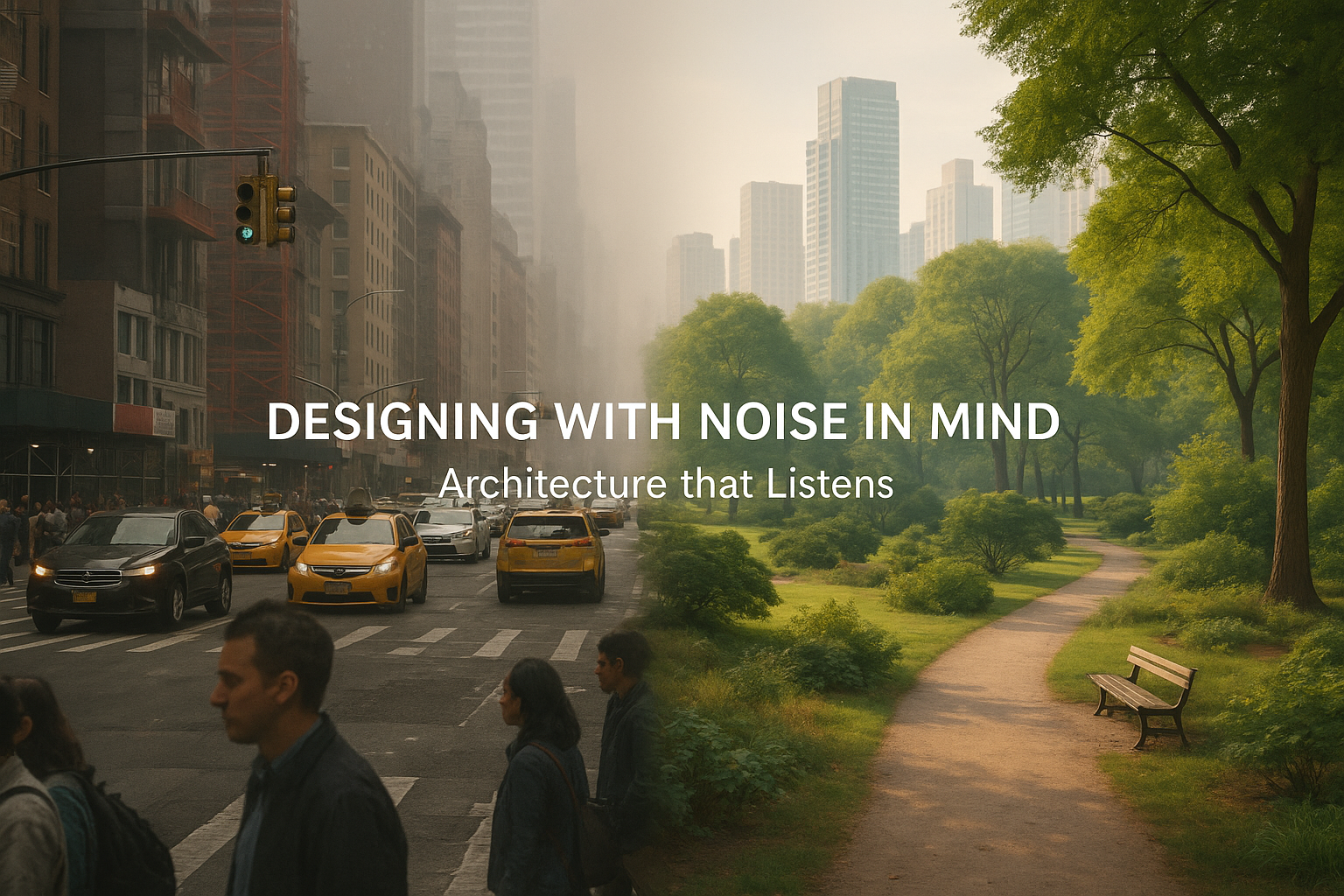The Sound of the City: Designing with Noise in Mind
In cities, we often talk about what we see. Towering skylines, green pockets, messy shopfronts, or the play of light on a rainy afternoon. But we rarely talk about what we hear. And yet sound — not just noise — shapes how we experience the city just as much as space, form, and material.
Noise is more than an inconvenience. It’s a physiological trigger, an emotional texture, a design failure or success. The constant thrum of traffic, the harsh whine of construction, the low hum of electrics — these aren’t neutral. They’re stressors. They invade our bodies. They raise cortisol, interrupt focus, distort sleep, and even blunt our capacity to feel safe.
As architects and urban designers, sound is one of the most powerful — and overlooked — levers we have to create cities that feel good to be in.
Urban Aliveness Isn’t Loudness
In Designing for Cities That Feel Alive, I wrote about vibrancy as more than busyness — it’s about richness, variation, texture. But liveliness is not synonymous with loudness. In fact, too much unmanaged noise is often what kills the sense of aliveness in a place. It pushes people indoors. It erodes social interaction. It drowns out subtle sensory cues that tell us we’re safe, connected, or curious.
Cities that feel alive tend to have:
Layered soundscapes (think birdsong + distant music + footsteps on stone)
Spaces where quiet is protected (parks, courtyards, arcades)
Rhythms of sound that change throughout the day
Instead of a relentless wall of engine noise, these cities offer a shifting sonic landscape. A place where ears can rest and tune back in — not just brace against the next auditory assault.
The Human Cost of Noise
Chronic urban noise has real consequences. Studies link it to increased risk of heart disease, anxiety, poor learning outcomes, and reduced attention spans. Children living near busy roads or flight paths often have impaired cognitive development. Adults in constant high-noise environments are more likely to suffer from stress-related illness and sleep disorders.
But it’s not only health. It’s culture. When city life becomes too loud, we lose the nuances. The spontaneous street conversations. The joy of buskers. The soft rituals of daily life — someone sweeping, a café doorbell, laughter down a laneway.
Soulful architecture begins by tuning into these details. It doesn’t just ask, “Can people move through this space?” It asks, “How will this place sound at 8am? At dusk? After rain?”
Designing with (and Against) Sound
So what can we do?
Good acoustic design in urban environments isn’t about silencing the city. It’s about creating balance. Curating the sounds we want to keep, while buffering or absorbing the ones that harm.
Some strategies:
Sound buffers: Trees, green roofs, and water features absorb and mask harsh noise.
Materials: Timber, fabric, earth, and certain plasters reduce reflection and soften ambient sound.
Building orientation: Positioning facades and entries away from noise sources can dramatically improve indoor comfort.
Spatial layering: Using arcades, thresholds, or internal courtyards to create gradients of sound.
Designing for delight: Sometimes it’s not about reducing noise but introducing pleasant sound — trickling water, gravel paths, chimes, or open windows to birdsong.
In schools, for example, this means more than acoustic panels in ceilings. It means designing to minimise corridor echoes, reduce traffic noise through landscaping, and allow natural sounds into the learning environment. For housing, it might mean thickened party walls, acoustic lobbies, or communal spaces tucked away from roads.
Biophilic Acoustics
Biophilic design offers more than visual connection to nature — it offers acoustic connection too. Sounds from the natural world have been shown to lower heart rate and blood pressure, ease mental fatigue, and promote psychological restoration.
Wind in trees, waves, cicadas, birdsong — these are not just poetic extras. They’re core components of spaces that feel human, safe, and nourishing.
Yet in most urban environments, these sounds are pushed to the edges, buried under the mechanical and industrial. The challenge — and opportunity — is to bring them back into the fold of our cities.
A City That Listens
What if we designed cities not only to be seen and moved through, but listened to?
A city that listens might:
Mandate acoustic performance as part of urban planning codes
Prioritise quiet zones and sonic diversity in public space design
Treat sound as a material — something to sculpt and compose
Celebrate local soundscapes as part of its identity
At Daedal, our design ethos is rooted in emotional architecture. That means paying attention to the invisible as much as the visible — and sound is one of the most powerful invisible forces there is. It shapes how a space feels, even if you can’t photograph it.
Designing with noise in mind is not a technical add-on. It’s a fundamental part of designing for human beings.
Final Thought: Quiet Is a Public Good
In a time when noise is the default, quiet becomes radical. Stillness becomes valuable. The ability to hear yourself think — or hear the wind in the trees — becomes a marker of care, craft, and resistance.
Architecture that cares about sound is architecture that cares about people. And that’s the kind of city I want to help build.
